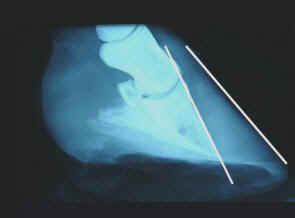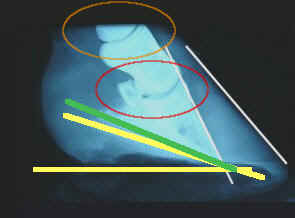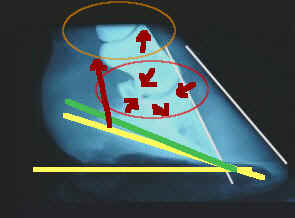Farriery Faux Pas
I'm
not so sure this plan was thought through so well
To get an idea of where I'm coming from, you can check
out a different 'article:' 08/08/14
My Opinions on Farriery and Where They Came From
The
Long Toe
So, again, lifting photos off the internet, these can be used
as a spring board for ideas but allowances need to be made so
that what is done is appropriate to the horse at hand. This is a guideline
only. This horse actually has a toe that has been 'pulled
forward' and may be at risk for underslung heels.
| What's going on |
What's going on II |
Vectors to Bring Ends Together |
 |
 |
 |
|
put a wedge under the foot that lifts it
the distance from the top yellow line to the green line. |
the red arrows indicate where you might
'bring the ends together' if you want to do it that way. |
the horizontal yellow line is 'ground' it's whatever
the bottom of the foot/hoof/sole is doing.
the lifted yellow line is the 'bottom' of the bone.
the angle between the two yellow lines is the horse's
'preference.' The length of the heel is what the
horse's body has figured out it needs to have in order for
the contraction in the body to be 'calm enough.'
Obviously, it would be better if there were no
contractions, but since there are, putting hoof under it
helps alleviate some of the stress involved. By
allowing the heel to be 'tall,' the foot isn't floating
somewhere off the ground and the tendons, ligaments, and
muscles on the back side of the leg aren't getting
traumatized every time the foot is put down. All the
stuff that is out of alignment is at least supported when
the heel is allowed to get tall.
Specifically - the tall heel is the horse's body's
solution. It's not the cause of the problem.
Something has pulled the leg back. (What? is the
million dollar question and needs to be investigated for a
complete solution!)
In any even, there is now a foot with a tall hell and a
long toe that sits behind where the leg needs to be for the
horse to be balanced.
This results in a mechanical problem in the hoof.
The long toe perpetuates the creation of a long toe.
But does it make sense to only take off the long toe?
The long toe is being created because the horse needs
something underneath that corner of it's table. It is
growing the long toe forward so it's doesn't fall on its
face.
It's growing the heel because for some reason the heel
doesn't make it down to the ground.

You've now got problems which probably started with
something contracted on the back side of the leg that is
now leading to strains near the fetlock and pasterns, concussive
problems on the front near the coronary band, pasterns,
fetlock, and maybe knee, and pulls up near the
throat. The musculature has probably gotten off as
the horse is perpetually catching itself from falling on
its face and perhaps the horse's whole way of going has
changed to accommodate the original
pattern.
It may have all started with the toe being left a little
too long.
This is an example of where the natural solution isn't
necessarily resulting in a good outcome.
Idea 1
If you know Ortho-bionomy, you can 'bring the ends
together' of the contracted places in the hoof, leg, and
torso of the horse. The red arrows give examples of
how this might be done.

In the picture, you can kind of see how the coffin bone is
jammed backward and running into the short pastern and the
short pastern is angled kind of odd w/ the long pastern
also. I would suspect there is deep tensor contraction - so that
would be compress the heel into the back of the fetlock
kind of thing.
This is may be eight to sixteen 'bringing the ends
together.' So you're maybe spending thirty to forty
minutes allowing for finding the correct vectors and for the
responses to travel through the system.
There are also check ligaments and several other mechanisms
at work and all of those would benefit from attending to as
well. So add on another twenty minutes. For folks who've been to the mini clinics,
you may remember that the hoof can be tilted or twirled as
well. That would for sure help. Add on some time
for that. Also, look to see how the heel bulbs are
doing.
Once the foot has been released, in this case, I think it's
important to
attend to the whole leg and how it's attaching itself to the
horse's body. From there, you might also consider an
overall pattern. (more on this elsewhere...)
If the leg was pulled back due to something going on in the
horse's body, you cannot fix the long toe only in the
foot. You have to find out what is going on in the
body. (Or the training or the person riding the horse or
what have you.)
If the problem is the farrier, you may need to have a long
talk.
Once the patterns creating the long toe
have been addressed, in the foot, in the body, *then* go ahead and trim up the foot. Or let the
horses natural movement take care of the excess heel and toe that the
horse can safely wear off. (The danger of leaving
it be is that the toe may be so built up it just needs to come
off.) (like squared off.)
At this point, the bones are better aligned and the muscles
are better released. The coffin bone will be
landing more properly because it doesn't have forces on it
that prevent it from doing so, and the leg will most likely
not need all of that tall heel or long toe.
Idea 2
If you have no idea what's happening in the tendons,
joints, or muscles, then the safest ortho-bionomy thing to
do is increase the angle (green line) just a little bit
more - that way you're pushing into what ever is already
contracting. by supporting the contraction, it will
hopefully give it up.

In real life, the angle of 'pushing into the contraction' could either be
straight up or around the pivot point - who knows until you
put your hands on it!
By putting a wedge under the foot you've covered both
bases.
The foot looks a worse for a few moments, but you just
do this for a few moments and then assess the
benefit. The wedge and the weight of the horse is
doing all the work. Physically and mentally.
You can have the horse stand on a slanted board, for
instance, for a few minutes and the weight of the horse
coupled with the slant will begin to release the
contractions. You can then walk the horse a little
bit (like a circle in the barn aisle kind of thing) to
integrate the changes then do a few more minutes on the
board. Repeat the walk. Assess what has been
accomplished.
At this time, the horse will most likely be landing more
solidly on the heel.
You can do this a few more times. Be judicious -
don't overdo it.
This allows for the natural movement of the horse to
begin wearing down the toe, or, if it makes sense to do it,
now go ahead and take off some of the toe. (With long
toes, I get a little radical and have not had problems, but
don't go out of *your* comfort zone.)
Bear in Mind
This is one component of the big picture.
The forces which created the long toe may still be at
work and what was released through working with the foot
and leg and body may not have addressed those. Or may
not be able to mitigate those forces.
For instance, an unbalanced rider, over time, can create
an imbalance in the horse which results in the horse
falling forward. (Think of all the upside down horses
you've seen!) If this is what is going on, a key element
that needs to be addressed, is also the rider.
The point is, where the long toe came from needs to be
investigated to make sure all factors contributing to it
are addressed.
And then there's more!
There's more about the rest of the horse and there's
more about what to do with all that extra hoof that's going
to be hanging off the front of the foot. But not
today.
|




![Centered Riding Today: An Informal Talk by Sally Swift [VHS]](http://ecx.images-amazon.com/images/I/41Vn6PfhzML._SL125_.jpg)
![Centered Riding with Sally Swift [VHS]](http://ecx.images-amazon.com/images/I/51OSh9kd9iL._SL125_.jpg)







